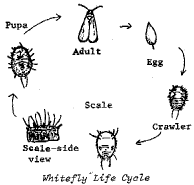|
|
DESCRIPTION:
The walnut husk maggot is occasionally found in the husks of butternuts, black, Persian and Japanese walnuts in early autumn, about the time nuts are harvested. The adult flies are small, slightly smaller than a housefly, with yellowish brown bodies. Their wings are masked with dark bands. They appear during the latter part of July and lay their eggs in punctures in the husks of the growing nuts. Larvae are 1-4 inch or a little longer, whitish maggots.
INJURY:
Injury is usually not serious but it may show up in three different
ways. It may impair the quality of the kernel within the shell, or
cause the husks to stick to the shell, or may be in part responsible
for blackening the shells which makes the nuts unattractive. Infested
nuts may fall from the tree prematurely, however, many remain on the
trees long after normal nuts have fallen to the ground.
LIFE HISTORY:
When the maggots are fully grown in the fall, they leave the husks
and enter the soil where they pupate and emerge as flies the
following year. The adult flies feed on the green husk of the nuts
and also soon deposit eggs in the husks.
Back to Pest Information
|
|
 |
DESCRIPTION: Adult whiteflies are small insects, approximately 1/16th inch (1.5mm) in length, with four powdery white wings. When heavily infested plants are disturbed, one may notice a ìcloudî of tiny white insects rising above it. The immature stages (eggs, crawlers, scales and pupae) are all yellowish and found primarily on the undersides of leaves. |
INJURY:
Whiteflies are sucking insects, feeding on plant sap. As a result
plants are weakened, may exhibit symptoms of stunting or wilting, and
may have large amounts of honeydew on them. In New York State, the
greenhouse whitefly is the most common species. It feeds on over 60
host plants. It usually does not survive our winters out of doors to
cause new infestations, but is brought in anew each year.
LIFE HISTORY:
The whitefly has a complex life history. It undergoes five distinct
stages of development. Eggs are laid on the undersides of the leaves,
and are at first pale yellow, but turn gray before hatching in 5 to 7
days. The crawler is a small, translucent, mobile stage that actively
searches for a feeding site. Within a few days crawlers settle down
and begin feeding, soon transforming to the sedentary scale stage.
The scale is a highly modified sucking insect, and its outer covering
thickens after it feeds giving it added protection. Adult development
(pupation) occurs within the scale cover. Four days later, adults
emerge. The life cycle takes about 40 days, depending on
temperature.
Back to Pest Information
|
AN UNWANTED HOUSE GUEST |
 |
The western conifer seed bug, Leptoglossus occidentalis (Heteroptera: Coreidae), is becoming a nuisance pest to some New York residents. The bug has the habit of entering buildings at the onset of cold weather in the late summer or early fall as it seeks a protected site to spend the winter. These bugs do not bite or sting, nor do they cause damage to the home. They will, however, give off a pungent odor if you handle them which is part of the insectís defensive strategy. They also may make a buzzing sound when flying. |
HISTORY:
The range of the western conifer seed bug has been expanding. In
1992 we began to get reports from western New York State about these
rather large insects in homes. The first documented collection of
this species in New York State was from an Orchard Park (Erie County)
home in January 1990. By February of 1992 Dr. Wayne Gall of the
Buffalo Museum of Science had received specimens from 9 counties of
western and central New York. By 1994 we were seeing samples from
Long Island and the lower Hudson Valley region.
This species was first described in 1910 from California, and was reported in Iowa in 1956. By the 1970's it was established in Wisconsin and Illinois, and by the mid-1980ís was found in Minnesota, southeastern Michigan and southwestern Ontario.
DESCRIPTION:
The western conifer seed bug belongs to the family Coreidae, commonly
called leaf-footed bugs, and like many members of this family, it has
a flattened, leaf-like expansion on the hind legs. The adult is
about æ inch (16-20 mm) in length and is dull brownish. There
is a faint white zigzag stripe across the midpoint of its upper
surface. When the insect takes flight, it lifts the wings to reveal
bright yellowish orange areas on its back.
The leaf-footed bugs use piercing sucking mouth parts to pierce the scales of conifer seeds and suck out the seed pulp. The list of host plants includes white pine, red pine, Scots pine, Austrian pine, mugo pine, white spruce, Douglas-fir and hemlock. Often these trees are planted or growing near homes, and if that is the case, the bugs may seek the nearby buildings as an overwintering site.
LIFE CYCLE:
In spring these bugs move out of doors to coniferous trees nearby.
The bugs feed on the developing seeds and early flowers of different
species of conifers. Females are reported to lay rows of eggs on
needles of the host trees, which hatch in about 10 days. Young
nymphs then begin to feed on tender cone scales and sometimes the
needles. The nymphs are orange and brown, becoming reddish-brown to
brown as they develop. Nymphs pass through five stages and reach
adulthood by late August. Adults feed on ripening seed until they
seek overwintering quarters.

|
This site is developed and administered by Lake Technology Solutions, Inc. | www.LakeTS.com | (888) 332-8082 |